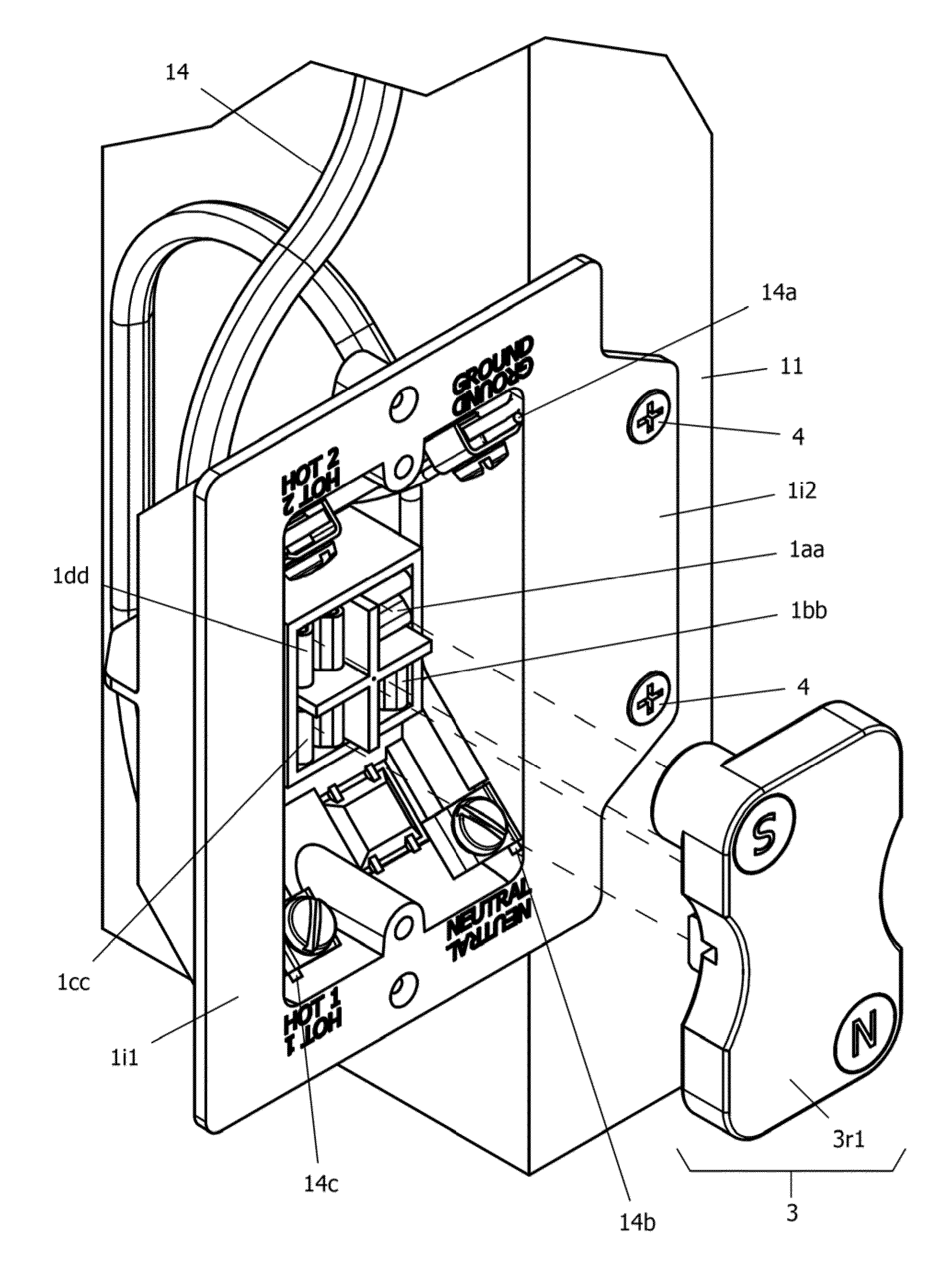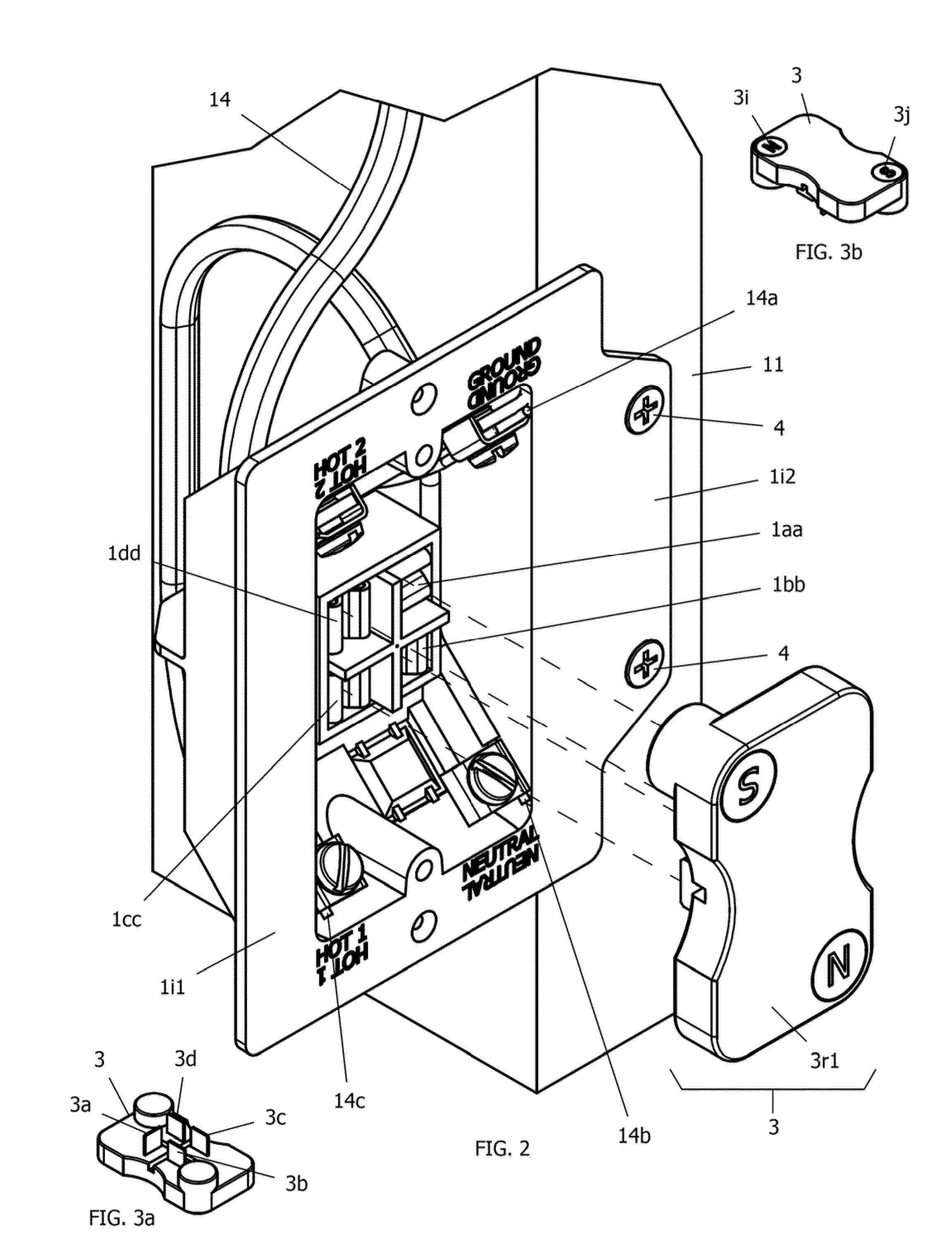Either way, this was significantly more difficult for ceiling installations because of the weight of the
drywall panels and the much more awkward overhead working position.
Once the
drywall was temporarily in place, however held, accurately determining the correct locations for the electrical box holes was difficult.
This is because the electrical boxes are behind the wide panel of drywall and cannot readily be located from the front.
Moreover they are often some distance from the edge of the drywall, making accurate hole location even more difficult.
However, to a greater or lesser degree, they are all rather unwieldy and without real commercial viability.
Because new work prior art electrical boxes were often designed to have their outer edges more or less flush with the front face of the drywall panel through the
cut-out holes, the temporarily positioned drywall panel was often bowed over those boxes during mark out and consequently its edges were distorted from their final installed positions.
Prior art electrical boxes that had a depth adjustment feature which allowed them to be initially flush with the rear face of the drywall (avoiding bowing) were still almost as difficult to accurately locate for hole mark out as other prior art alternatives.
It follows that power outlet holes in drywall were prone to be mispositioned, sometimes necessitating unsightly repairs or the scrapping of material.
Prior art installation of drywall has been labor intensive and
time consuming because it was often first put up into place for the
marking out of power outlet and electric switch holes, taken down in order to
cut the holes and then finally repositioned for permanent installation.
Another problem with the prior art has been its awkward nature and the time it took to wire wall and ceiling power outlets, or light fittings and electric switches.
This makes it cumbersome to install the power outlet, electric switch, or light fitting, particularly if more than one
power cable needs to be used.
Moreover, wiring the power outlet, electric switch, or light fitting was often cumbersome and
time consuming because the wires had to be held in the right place, wrapped around the electrical terminals, then held steady while the terminal screws were tightened.
In the case of prior art ceiling outlets for light fittings, the wiring of light fittings has been even more cumbersome because of having to work overhead and at the same time bear the weight of the light fitting.
Even then, their size and bulky shape usually obstructed the electrical box, making wiring more difficult.
However, to a greater or lesser degree, they have all fallen short of a complete solution for a number of reasons, which will now be explained.
While this patent includes some novel safety features (column 2, lines 20-24), it is questionable whether the North American
construction industry found these features of sufficient compelling value for the product to remain commercially viable for long.
Moreover, this safety module electrical
distribution system fails to address the issues of speeding up or simplifying the wiring of its associated electrical box.
This safety module electrical
distribution system also completely fails to teach any improvement to the drywall installation process.
The connections between the circuit box and the various modular inserts are flimsy and prone to misalignment and breakage.
Like the previous reference, this reference fails to address the issues of speeding up or simplifying the wiring of its circuit box or installation of the drywall.
Moreover, relying on the
power cable's wires as its sole means of support once connected make them vulnerable to fracture, particularly when considering the
brittleness typically induced in wiring by the cyclical heating and cooling that naturally occurs when electrical power is cycled on and off over a prolonged period.
However, there is no elaboration on how that might be accomplished.
It follows that, in the likely event of an electrical disconnection, the broken or loose wires would not be able to be re-connected without removal of the surrounding drywall, an unacceptable inconvenience to the user.
Moreover, like the previous reference, this reference also fails to teach any improvement to the drywall installation process.
In similar fashion to the previous reference, the wiring connection arrangement is highly problematic and the power
distribution system as a whole completely fails to teach any improvement to the drywall installation process.
While this version uses a more robust method of connection, the connections are still not accessible once the drywall has been permanently installed.
So as before, in the event of an electrical disconnection, the electrical box cannot be re-connected without removal of the surrounding drywall.
Likewise, these references also completely fail to teach any improvement to the drywall installation process.
These are also similarly problematic for
power cable connection and drywall installation.
Moreover, when the fan or light fitting needs to be replaced, the owner is also restricted to
purchasing a replacement with the same exact receptacle plate (which may well not be available).
Like the previous references, this reference failed to teach speeding up or simplifying wiring of the electrical box or installation of the drywall.
This device requires that the drywall sheet be temporarily offered up into its installed position and be taken back down again, which is now an unnecessary and laborious additional step (Summary, column 1, lines 40-62).
Moreover, this device does very little to speed up the process of accurate electrical box hole location and
cutting.
 Login to View More
Login to View More 


